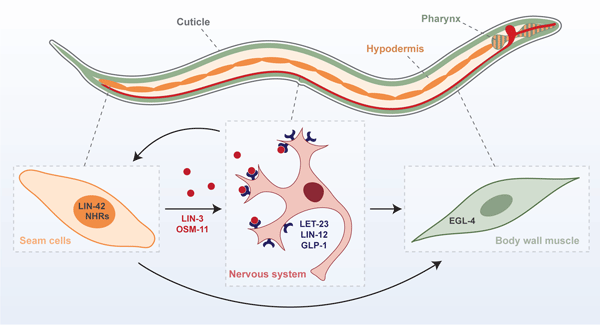Environmental conditions as well as physiologic factors, including the size, stage, and nutritional status of the organism, determine the frequency and number of molts in the life cycle of various ecdysozoans. However, neuroendocrine pathways that regulate the production of molting hormones in response to sensory cues or biological feedback are not well understood.
In insects, the steroid hormone ecdysone promotes renewal of the exoskeleton and gene expression programs appropriate for the post-molt developmental stage. The neuropeptide PTTH, made in the central nervous system (CNS), regulates the production of ecdysone. The peptide hormones EH and ETH, produced, respectively, in the CNS and epitracheal glands, elicit escape from the old skeleton (ecdysis). The neuropeptide bursicon promotes sclerotization of the new skeleton after ecdysis.
Steroid hormones also regulate the post-embryonic development of nematodes, and molting of C. elegans requires nuclear hormone receptors conserved among metazoans. However, a specific hormone that promotes molting has yet to be identified in any nematode.
Our laboratory seeks to identify endocrine and possibly neuroendocrine pathways regulating the molting cycle of C. elegans. As one approach, we have isolated mutants that initiate supernumerary molts after reproductive maturity. We expect some of the corresponding genes to work in neurons or related secretory cells possibly analogous to the corpus allatum of insects, which secretes the isoprenoid juvenile hormone. Other genes may function in the heterochronic pathway that includes the conserved microRNA let-7 and promotes the terminal differentiation of the epidermis.
Through comprehensive exploration of the molting cycle of C. elegans, we expect to discover novel, conserved mechanisms for the neuroendocrine control of animal development.
